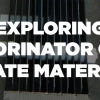Understanding Chlorinator Cell Voltage
Welcome to the Chlorinator Cells blog, where we provide valuable information about chlorinator cell maintenance, troubleshooting, and best practices. In this article, we will discuss voltage and its importance in ensuring efficient pool water chlorination.
A chlorinator cell is a crucial component of a saltwater chlorinator system. It utilizes electrolysis to convert salt into chlorine gas, which helps sanitize the pool water. The voltage applied to the chlorinator cell plays a significant role in the chlorine production process and overall system performance.
The Role of Voltage in Chlorinator Cells
Voltage is the electrical potential difference applied across the chlorinator cell. It determines the rate of chlorine gas production during the electrolysis process. The higher the voltage, the more chlorine gas is generated. However, it’s important to maintain the voltage within the manufacturer’s recommended range to prevent damage to the cell and ensure optimal performance.
Optimal Voltage Range
The optimal voltage range for chlorinator cells varies depending on the specific make and model. It is crucial to consult the manufacturer’s documentation or user manual for the recommended voltage range. Generally, the voltage range falls between 5 to 7 volts for most chlorinator cells.
Operating the cell within the specified voltage range ensures efficient chlorine production and prolongs the lifespan of the cell. If the voltage is too low, the chlorinator cell may not produce enough chlorine, leading to ineffective sanitization. Conversely, excessively high voltage can cause accelerated wear and tear on the cell, reducing its longevity.
Monitoring and Adjusting Chlorinator Cell Voltage
Regularly monitoring the voltage is essential for maintaining optimal performance. Many saltwater chlorinator systems come with built-in monitoring features that display the cell voltage. Additionally, specialized pool maintenance tools, such as multimeters, can be used to measure the voltage accurately.
If the voltage reading falls outside the recommended range, adjustments may be necessary. However, it is important to follow the manufacturer’s guidelines or seek professional assistance to make any voltage adjustments. Modifying the voltage without proper knowledge can lead to irreparable damage to the chlorinator cell or the entire system.
Revitalize Your Pool with Premium Chlorinator Cells!
Experience crystal-clear water with our top-quality chlorinator cells.
Say goodbye to maintenance hassles and hello to hassle-free pool enjoyment.
Shop now and enjoy the following benefits:
- Long-lasting performance for uninterrupted pool maintenance.
- Effortless installation for both novice and experienced pool owners.
- Advanced technology for efficient chlorine production.
- Exceptional water quality that you and your family deserve.
Wrap Up
Voltage plays a crucial role in the efficient operation of saltwater chlorinator systems. Maintaining the voltage within the recommended range ensures optimal chlorine production, effective pool water sanitization, and prolongs the lifespan of the cell. Regular monitoring and adherence to the manufacturer’s guidelines are key to achieving and maintaining the correct voltage levels.
For more information on chlorinator cell maintenance, troubleshooting, and other related topics, please continue exploring our blog or contact us directly.

 07 3485 0008
07 3485 0008







Leave a reply